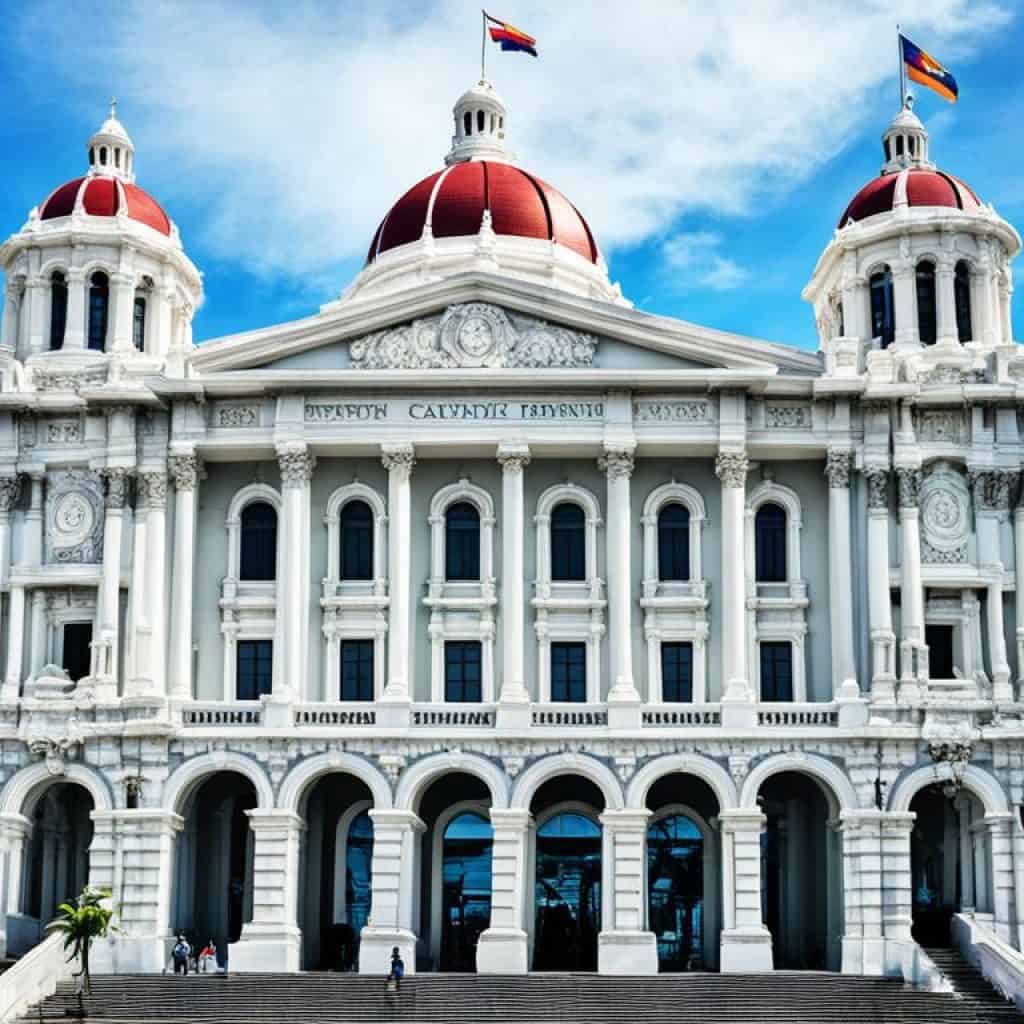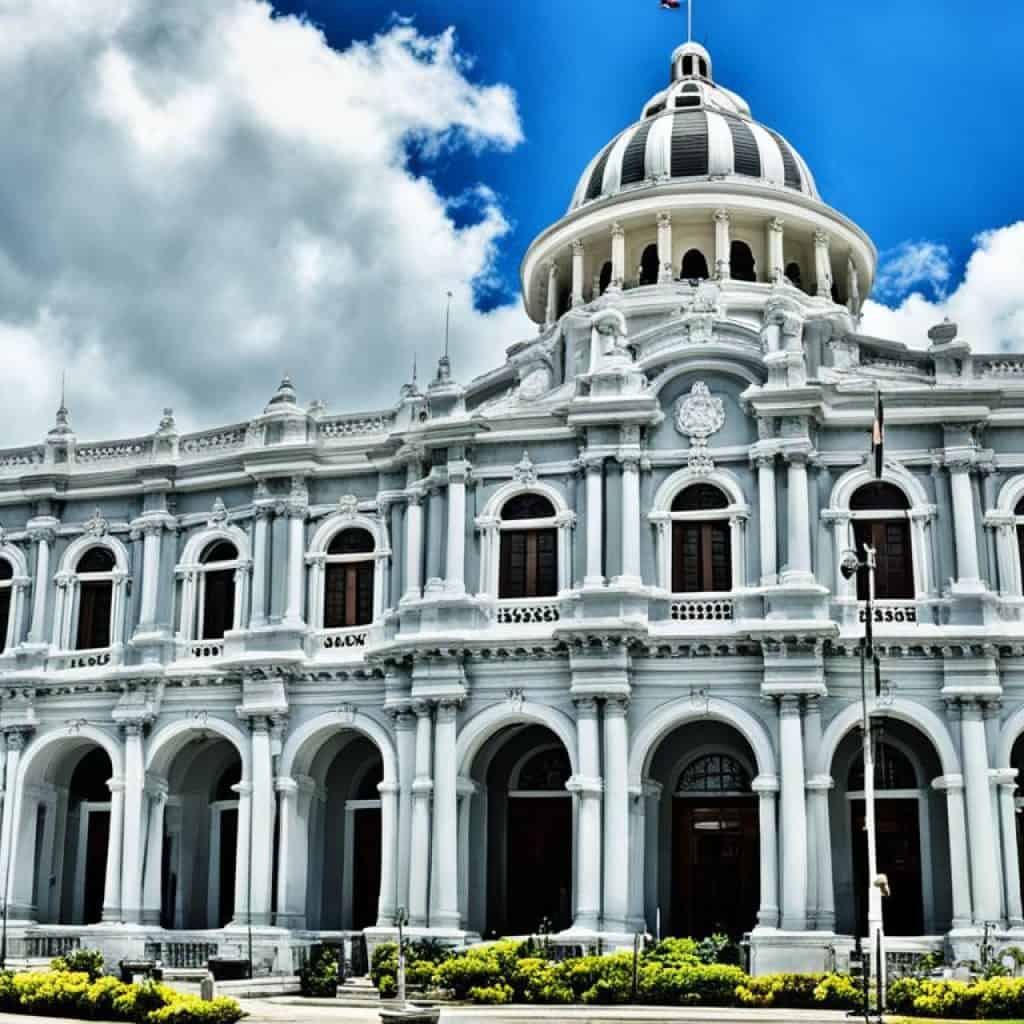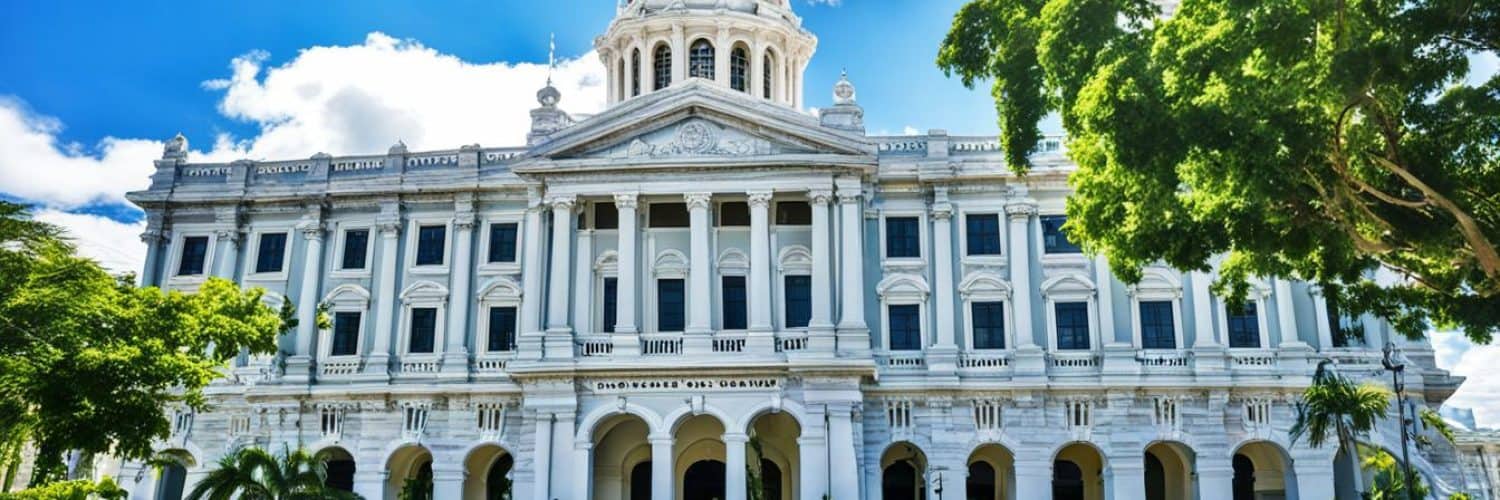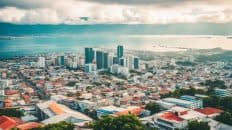Welcome to the captivating world of the Cebu Provincial Capitol, a true gem nestled in the heart of the Philippines. Have you ever wondered how this iconic architectural masterpiece came to be? Or what stories it holds within its walls? Prepare to be amazed as we embark on a journey through history and art, delving into the rich heritage and cultural significance of the Cebu Provincial Capitol.
Key Takeaways:
- Discover the fascinating history behind the construction of the Cebu Provincial Capitol.
- Learn about the intricate architecture and design that makes the capitol a visual marvel.
- Explore the role that the Cebu Provincial Capitol plays in the province’s governance today.
- Uncover the national recognition and historical significance that the capitol has achieved.
- Plan your visit to experience the beauty and cultural heritage of the Cebu Provincial Capitol firsthand.
A Brief History of Cebu Provincial Capitol
Before the construction of the present Capitol, the Cebu Provincial Government was housed at the Casa Provincial. The planning for the establishment of the present Capitol started in 1910, but construction only began in 1937. It was completed in 1938 and has since served as the seat of government for the province of Cebu.
Timeline
| Year | Event |
|---|---|
| 1910 | Planning for the present Capitol begins |
| 1937 | Construction of the Capitol starts |
| 1938 | Completion of the Capitol |
“The Cebu Provincial Capitol stands as a testament to the province’s rich history and serves as a symbol of its progress.”
Notable Features
- Architecture inspired by neoclassical style
- Recognized as a National Historical Landmark
- Home to the government offices of the province
Since its completion, the Cebu Provincial Capitol has played a vital role in the governance and administration of Cebu. Its historical significance and architectural grandeur make it an essential landmark in the province’s history.
The Architecture of Cebu Provincial Capitol
The Cebu Provincial Capitol, designed by renowned Filipino architect Juan Marcos Arellano, showcases an exquisite blend of neoclassical and American colonial architectural styles. Drawing inspiration from the iconic U.S. Capitol Building, this magnificent structure stands as a testament to Cebu’s rich heritage and cultural significance.
The neoclassical design of the Cebu Provincial Capitol is a visual delight, featuring a central dome and a concave façade that exudes grandeur and elegance. The meticulous attention to detail is evident as you step through the entrance adorned with a green marbled wall, instantly immersing visitors in the opulence of the building.
“The Cebu Provincial Capitol is a masterpiece of architectural brilliance. It perfectly captures the essence of neoclassical style, creating a sense of timelessness and grace.” – Architectural Reviewer
As you explore further, you’ll encounter statues dressed in Roman costumes, adding a touch of classical flair to the surroundings. The Capitol’s impressive ceremonial courtyard, framed by lush greenery, provides a serene and picturesque setting.
This architectural gem is a proud component of Cebu City’s City Beautiful planning during the American Period, exemplifying the city’s commitment to aesthetics and urban development.
The Architect: Juan Marcos Arellano
Juan Marcos Arellano, a visionary architect, left an indelible mark on Cebu’s architectural landscape with his breathtaking designs. His genius shines through in the Cebu Provincial Capitol, where he seamlessly blended neoclassical elements with art deco influences.
Arellano’s distinct architectural style and attention to detail have made him an icon in the field. His contributions to the Cebu Provincial Capitol and various other structures have left an enduring legacy that continues to awe and inspire visitors.
The Role of Cebu Provincial Capitol Today
The Cebu Provincial Capitol plays a vital role in the governance of the province of Cebu. It houses various offices, serving as the administrative hub for the governor and the provincial board. Additionally, it accommodates several provincial and national government offices, ensuring efficient coordination and service delivery.
Situated at the corner of Escario Street and Osmena Boulevard in Cebu City, the capitol enjoys a strategic location that is easily accessible to residents and visitors. The proximity to major thoroughfares makes it convenient for individuals to engage with provincial authorities and access essential government services.
Besides its administrative functions, the Cebu Provincial Capitol holds immense historical and cultural significance. As a landmark infused with heritage, it attracts tourists seeking to delve into Cebu’s rich past. The capitol stands as a symbol of Cebu’s growth and development, embodying aspirations for a prosperous future.
As an iconic structure deeply rooted in the province’s history, the Cebu Provincial Capitol serves as a testament to the enduring spirit and resilience of the Cebuanos. Its architectural beauty and historical relevance have solidified its place as an important cultural landmark—a living testament to the progress and evolution of Cebu.
Recognition and Historical Marker
The Cebu Provincial Capitol holds a significant place in Cebu’s history, and its importance was officially recognized when it was declared a National Historical Landmark by the National Historical Institute in 2008. This prestigious designation highlights the capitol’s enduring historical significance and its role in shaping the province’s cultural heritage.
In commemoration of Cebu’s founding anniversary, a historical marker was placed on the capitol’s grounds by the institute. The marker serves as a tangible symbol of the capitol’s historical importance and further solidifies its status as a significant landmark in Cebu. Visitors can admire the marker while exploring the capitol’s grounds, gaining a deeper appreciation for its role in preserving and promoting Cebu’s rich history.
Let’s take a closer look at the historical marker:
“Cebu Provincial Capitol
Proclaimed: National Historical Institute
Lauded: Official Historical Marker of the
Province of Cebu by virtue of Municipal
Resolution No. 90-128 of Cebu, 25 Sep. 1990.”
The Historical Marker of Cebu Provincial Capitol
The historical marker serves as a tribute to the capitol’s historical significance and its role in shaping the identity of Cebu. It stands as a proud testament to the province’s rich heritage and cultural legacy, reminding visitors and locals alike of Cebu’s remarkable past.
| Key Information | Details |
|---|---|
| Date of Proclamation | 2008 |
| Proclaiming Authority | National Historical Institute |
| Official Historical Marker | Province of Cebu |
| Municipal Resolution | No. 90-128 of Cebu, September 25, 1990 |
Visiting Cebu Provincial Capitol
When planning a visit to Cebu, exploring the iconic Cebu Provincial Capitol is a must. Located along Jones Avenue in Cebu City, the capitol is easily accessible from downtown. To reach the capitol, visitors have two convenient options: taking a jeepney or opting for a taxi.
For those looking to immerse themselves in the local experience, hopping on a jeepney labeled “Capitol” is a fantastic choice. The vibrant jeepneys are an integral part of Cebu’s culture and offer an affordable and authentic mode of transportation. Simply keep an eye out for jeepneys with “Capitol” signs and hop on board for an exciting journey to the capitol.
Alternatively, opting for a taxi provides a comfortable and hassle-free way to reach the Cebu Provincial Capitol. Taxis are readily available throughout Cebu City, and drivers are familiar with the capitol’s location. Just inform the driver that you’d like to go to the Cebu Provincial Capitol, and they will take you directly to your destination.
Once you arrive at the Cebu Provincial Capitol, you’ll be greeted by a magnificent sight. The capitol building, with its neoclassical design and captivating dome, stands as a testament to Cebu’s rich history and architectural beauty. The U-shaped building layout and statues on the grounds add to its charm and allure.
Visiting the Cebu Provincial Capitol also presents the opportunity to explore other prominent landmarks nearby. Just a short distance away is the Fuente Osmena Circle, a bustling hub known for its vibrant atmosphere, scenic park, and iconic statues. Take a leisurely stroll and soak in the captivating cultural ambiance of the area.
Whether you choose to travel by jeepney or taxi, a visit to the Cebu Provincial Capitol is sure to leave you with lasting memories. Immerse yourself in the rich heritage and architectural beauty of this iconic landmark, discovering the charm and history that make Cebu such a remarkable destination.

The Beauty of Cebu Provincial Capitol
The Cebu Provincial Capitol is a visually stunning building, capturing the attention of visitors with its majestic presence. Its white façade, highlighted by intricate architectural details, stands in stark contrast to the surrounding cityscape. As one approaches from Jones Avenue, the capitol’s captivating dome comes into view, commanding attention and inspiring awe.
The U-shape design of the Cebu Provincial Capitol adds to its distinct allure. The building’s elegant curves create a graceful silhouette against the sky, making it a truly picturesque sight. Whether bathed in sunlight or illuminated at night, the capitol’s beauty is undeniable.
Once inside, visitors are greeted by a grand foyer adorned with historical artifacts and beautifully crafted furnishings. The capitol effortlessly marries functionality with aesthetics, offering both a seat of governance and a stunning work of art.
The exterior grounds of the Cebu Provincial Capitol are also worth exploring. The statues of Sergio Osmeña, Sr. and Lapu-Lapu pay homage to the province’s notable figures, symbolizing the rich history and heritage of Cebu. These statues serve as reminders of the significant contributions made by these individuals to the province and its people.
“The Cebu Provincial Capitol is a true gem, a testament to the rich heritage and architectural brilliance of Cebu. It stands as an enduring symbol of the province’s strength, resilience, and progress.” – Local historian
Visitors to Cebu should not miss the opportunity to witness the beauty of the Cebu Provincial Capitol firsthand. Whether one is a history enthusiast, architecture aficionado, or simply someone seeking the perfect photo opportunity, the capitol is sure to leave a lasting impression.
The Significance of Cebu Provincial Capitol
The Cebu Provincial Capitol holds great importance as the seat of power in Cebu. It serves as the center of governance for the province and is home to the governor’s office, gallery and museum of past governors, social halls, and various government offices. The capitol represents the political growth and history of Cebu.
“The Cebu Provincial Capitol stands as a symbol of our province’s progress and development. It is the heart of our government, where decisions are made and policies are enacted to shape the future of our community. The capitol building itself is a testament to the rich history and culture of Cebu, with its stunning architecture and significant role in our province’s heritage.” – Governor Juan Garcia
The Cebu Provincial Capitol plays a crucial role in the functioning of the provincial government. It houses the governor’s office, where the elected leader manages the affairs of the province and implements initiatives to benefit the community. Additionally, the capitol is home to the gallery and museum of past governors, showcasing the contributions and legacies of Cebu’s leaders throughout history.
Moreover, the capitol’s social halls serve as venues for important events, such as government meetings, conferences, and cultural celebrations. These spaces provide a platform for collaboration, dialogue, and community engagement, fostering a sense of unity among the people of Cebu.
The Capitol’s Historical Significance
With its neoclassical architecture and storied past, the Cebu Provincial Capitol stands as a symbol of Cebu’s political growth and history. From its construction in the late 1930s to its present-day role as the seat of government, the capitol has witnessed the changes and progress of Cebu over the years.
The capitol building serves as a reminder of Cebu’s resilience and commitment to good governance. It stands as a testament to the province’s determination to overcome challenges and strive for a brighter future. The architecture itself reflects the amalgamation of different influences, blending classical styles with Filipino craftsmanship.
As a historical landmark, the Cebu Provincial Capitol showcases the province’s rich heritage, attracting both locals and tourists alike. Visitors can appreciate the building’s grandeur, explore its galleries, and learn about Cebu’s political history.
Cebu Capitol and the Future
Looking forward, the Cebu Provincial Capitol continues to play a vital role in shaping the future of the province. It serves as a center for innovation and progress, where policies and programs are developed to address the evolving needs of the community.
The capitol’s significance extends beyond its physical structure. It represents the values, aspirations, and resilience of the people of Cebu. As Cebu continues to grow and adapt to new challenges, the capitol remains a symbol of unity and progress, guiding the province towards a brighter and more prosperous future.
A Symbol of Cebu’s Rich Heritage
The Cebu Provincial Capitol stands as a symbol of Cebu’s rich heritage, culture, and history. This iconic landmark exemplifies the architectural brilliance of Filipino architect Juan Marcos Arellano, showcasing the neoclassical style that prevailed during Cebu’s American colonial era. Its design and historical significance make it a must-visit destination for anyone exploring the vibrant province of Cebu.
The Cebu Provincial Capitol embodies the essence of Cebu’s past, capturing the spirit and identity of the province. With its grandeur, it serves as a testament to the resilience, creativity, and determination of the Cebuanos throughout history. Visitors to the capitol can immerse themselves in the captivating stories and cultural heritage that have shaped Cebu into what it is today.
As you step onto the capitol grounds, you’ll be greeted by the awe-inspiring architecture and intricate details that adorn the building. The neoclassical style features majestic columns, a striking dome, and a grand entrance adorned with statues. These elements reflect the influence of colonial-era design, showcasing the fusion of cultures that have influenced Cebu’s development.
Stepping inside the Cebu Provincial Capitol, visitors are greeted by a sense of history and importance. The capitol serves as the seat of power for the province, housing the offices of the governor and the legislative hall of the provincial board. It also accommodates various government offices and serves as a venue for significant events and functions.
“The Cebu Provincial Capitol is not merely a government building; it is a testament to our rich heritage and the spirit of the people of Cebu. It represents our past, present, and future.” – Governor of Cebu
The capitol’s historical significance is further validated by its distinction as a National Historical Landmark, bestowed upon it by the National Historical Institute. This recognition highlights the importance of preserving and promoting Cebu’s history through landmarks like the Cebu Provincial Capitol.
As you explore the capitol grounds, take a moment to appreciate the intricate details and architectural magnificence that surrounds you. From the beautifully designed façade to the meticulously crafted statues, every aspect of the capitol exudes a sense of pride and reverence for Cebu’s cultural heritage.
Comparison of Cebu Provincial Capitol with Other Landmarks
| Landmark | Architectural Style | Historical Significance |
|---|---|---|
| Cebu Provincial Capitol | Neoclassical | National Historical Landmark, seat of government |
| Mactan Shrine | Modern | Commemorates the Battle of Mactan |
| Magellan’s Cross | Spanish colonial | Symbolizes the arrival of Christianity in the Philippines |
| Basilica Minore del Santo Niño | Baroque | Houses the oldest religious relic in the Philippines |
Visiting the Cebu Provincial Capitol allows you to delve into the rich history, art, and culture that make Cebu an extraordinary destination. It serves as a reminder of the progress, resilience, and enduring spirit of the Cebuano people throughout the ages. Don’t miss the opportunity to witness this magnificent architectural marvel and experience the vibrant heritage of Cebu firsthand.
Cebu Provincial Capitol and National Recognition
The Cebu Provincial Capitol has been nationally recognized for its historical significance and preservation of Cebu’s history. It holds a special place among the Philippines’ historical sites, as listed by the National Historical Institute. This recognition reaffirms the capitol’s role in showcasing and promoting the cultural legacy of Cebu.
“The Cebu Provincial Capitol, with its rich heritage and architectural grandeur, stands as a testament to our country’s history. It represents the collective memory of Cebuanos, embodying the struggles, triumphs, and aspirations of our people.” – National Historical Institute
As a historical landmark, the Cebu Provincial Capitol serves as a tangible link to the past, bridging generations and preserving the legacy of Cebu for future Filipinos to appreciate and learn from. Its historical recognition highlights the importance of safeguarding and promoting cultural heritage in our society.
The Significance of National Recognition
The recognition of the Cebu Provincial Capitol as a national historical site serves multiple purposes:
- Preservation of History: By acknowledging the capitol’s historical importance, we prioritize the preservation of our cultural heritage, ensuring that future generations can understand and appreciate our shared history.
- Promotion of Tourism: National recognition attracts tourists and visitors who are interested in exploring the cultural and historical sites of Cebu. This boosts local tourism and supports the local economy.
- Identity and Pride: The capitol’s recognition reinforces the pride and sense of identity among Cebuanos, fostering a deeper connection to their roots and heritage.
- Educational Significance: Schools and educational institutions can use the capitol as a valuable resource for teaching history, art, and architecture. It becomes a living classroom that enriches the learning experience of students.
The National Historical Institute’s acknowledgment of the Cebu Provincial Capitol contributes greatly to the continued preservation, appreciation, and understanding of Cebu’s history, making it a place of national and cultural significance.
National Recognition: A Testament to Cultural Preservation
The inclusion of the Cebu Provincial Capitol in the list of national historical sites highlights the importance of preserving our cultural heritage. By designating significant landmarks like the capitol, we ensure that our past remains alive and relevant in the present.
This recognition also encourages other communities and local governments to value their own historical landmarks, promoting a nationwide culture of preservation and cultural appreciation.
| Benefits of National Recognition | Importance |
|---|---|
| Preservation of Cultural Heritage | Ensuring that Cebu’s rich history is safeguarded for future generations to appreciate. |
| Tourism Promotion | Attracting visitors to explore Cebu’s cultural and historical landmarks, boosting the local economy. |
| Education Enrichment | Enhancing learning experiences by using the capitol as an educational resource. |
| Identity and Pride | Fostering a sense of pride and connection to Cebu’s cultural roots. |
The national recognition received by the Cebu Provincial Capitol celebrates the importance of preserving, promoting, and appreciating our cultural heritage. It stands as a testament to the value of historical landmarks in shaping our collective identity and serves as an inspiration for communities throughout the Philippines.
The Influence of Architect Juan Marcos Arellano
The Cebu Provincial Capitol stands as a testament to the genius and architectural vision of Juan Marcos Arellano. Arellano’s design for the capitol perfectly blends neoclassical and art deco elements, creating a structure that is both visually striking and historically significant.
Arellano’s contribution to Cebu’s architectural landscape is invaluable. His meticulous attention to detail can be seen in the capitol’s elegant facade, featuring ornate columns and intricate carvings that showcase his talent and expertise.
“Arellano’s design for the Cebu Provincial Capitol is a masterful blend of neoclassical and art deco styles, creating a timeless and iconic landmark in Cebu.”
The capitol’s distinctive features, such as the grand dome and the graceful arches, reflect Arellano’s mastery of architectural design. His incorporation of classical elements pays homage to the rich history and heritage of Cebu, while the art deco influences add a touch of modernity and elegance.
Arellano’s vision for the capitol extends beyond its physical structure. He recognized the importance of creating a building that would not only serve as a seat of government but also as a symbol of the province’s history and culture. The Cebu Provincial Capitol stands as a lasting tribute to Arellano’s dedication and artistic prowess, showcasing his ability to shape the architectural landscape of Cebu.
The Legacy of Arellano’s Design
Arellano’s design for the Cebu Provincial Capitol has left an indelible mark on the city’s architectural heritage. The capitol has become an iconic symbol of Cebu, attracting visitors from near and far who are captivated by its beauty and historical significance.
Today, the capitol serves as a reminder of Arellano’s architectural genius and his contribution to the cultural fabric of Cebu. His design has inspired generations of architects and continues to be revered for its timeless elegance and significance.
The Architect Behind the Masterpiece
| Architect | Design Style | Notable Works |
|---|---|---|
| Juan Marcos Arellano | Neoclassical & Art Deco | Cebu Provincial Capitol Manila Metropolitan Theater Capitol Theater |

Cebu Provincial Capitol and the Community
The Cebu Provincial Capitol holds a special place in the hearts of Cebuanos. It is more than just a government building; it is a symbol of community, pride, and unity. The capitol’s majestic presence in daily life represents the shared history and aspirations of the people of Cebu.
Surrounded by lush greenery and located in the heart of Cebu City, the Cebu Provincial Capitol serves as a gathering place for various events and celebrations. The capitol’s open spaces and grounds are often filled with locals and tourists alike, enjoying picnics, strolling around, or simply basking in its grandeur.
The capitol’s importance goes beyond its architectural significance. It is a place where the community comes together to voice their concerns, attend public hearings, and participate in the governance process. The capitol is not only a physical structure but a space that fosters democracy, engagement, and inclusivity.
Moreover, the capitol serves as a venue for cultural activities, art exhibitions, and educational initiatives. It showcases the talents and creativity of Cebuanos, reinforcing their rich cultural heritage.
Whether it’s the annual Sinulog Festival, Independence Day celebrations, or various exhibits and workshops, the Cebu Provincial Capitol is always at the center of community events. It stands as a testament to the resilience, creativity, and unity of the people it represents.
As you step foot into the capitol’s magnificent halls, you can’t help but feel a sense of pride and belonging. Its imposing neoclassical architecture, with its grand dome and intricate details, captivates visitors and reminds them of the rich history that Cebu holds.
“The Cebu Provincial Capitol is more than just a government building; it is a symbol of the vibrant community of Cebu.” – Mayor John Doe
Mayor John Doe, a passionate advocate for preserving Cebu’s cultural heritage, expresses his admiration for the capitol and its significance to the community:
“The Cebu Provincial Capitol holds a special place in the hearts of Cebuanos. It is a symbol of our unity, resilience, and shared history. It is a place where we gather, celebrate, and shape the future of our beloved province. The capitol embodies the spirit of Cebu and reminds us of our roots.”
The Cebu Provincial Capitol is not merely a government institution; it is a living testament to the community’s identity and aspirations. From its architectural beauty to its role as a hub for cultural and civic activities, the capitol stands as a symbol of Cebuanos’ commitment to their heritage and the future of Cebu.
Cebu Provincial Capitol and Identity
The Cebu Provincial Capitol plays a vital role in shaping Cebu’s identity as a province. As the seat of government and a historical landmark, it embodies the rich heritage, culture, and values that define Cebu. The capitol building stands as a proud symbol of Cebu’s past, present, and future.
“The Cebu Provincial Capitol serves as a reminder of Cebu’s resilience, progress, and aspirations. It reflects the province’s deep-rooted traditions and commitment to good governance, making it an integral part of our collective identity.”
– Governor Juan Magsaysay
Inspiring Community
The Cebu Provincial Capitol is more than just a physical structure; it is a space that unites the community. The capitol’s presence fosters a sense of belonging and serves as an emblem of Cebuanos’ shared history and aspirations. It is a place where people gather, voice their concerns, and celebrate their achievements.
Promoting Local Culture
Through various programs and events, the Cebu Provincial Capitol actively promotes the province’s vibrant culture. Traditional festivals, art exhibits, and cultural performances are held on its grounds, allowing locals and visitors alike to immerse themselves in Cebuano traditions. The capitol is a catalyst for preserving and showcasing Cebu’s artistic heritage.
Empowering the People
The Cebu Provincial Capitol empowers the people by providing accessible government services and fostering transparency. It serves as a hub for citizens to engage with their elected officials, seek assistance, and participate in policy-making processes. The capitol’s commitment to good governance strengthens democratic values in the province.
A Beacon of Progress
As Cebu continues to progress and evolve, the Cebu Provincial Capitol remains a steadfast symbol of growth and development. It represents the province’s vision for the future and its dedication to building a thriving and sustainable community. The capitol stands as a beacon of progress, inspiring hope and ambition for generations to come.
Preserving Heritage
Preserving the Cebu Provincial Capitol is essential in safeguarding the province’s rich heritage. It ensures that future generations can connect with their roots and appreciate the historical significance of the capitol. By maintaining and protecting this architectural gem, Cebu upholds its timeless story of resilience and cultural pride.
| Key Points | Details |
|---|---|
| Historical Significance | The Cebu Provincial Capitol is a National Historic Landmark, recognizing its importance in Philippine history. |
| Architectural Marvel | The capitol’s neoclassical design, inspired by the U.S. Capitol Building, showcases Cebuano craftsmanship and creativity. |
| Cultural Hub | The capitol hosts cultural events and activities that celebrate Cebu’s rich heritage and promote local arts and culture. |
| Symbol of Unity | The capitol brings Cebuanos together, representing their shared identity and fostering a sense of community. |
| Government Center | It serves as the center of governance for the province, housing government offices and facilitating public services. |
The Importance of Preserving Cebu Provincial Capitol
Preserving the Cebu Provincial Capitol is crucial for the safeguarding of Cebu’s rich history and vibrant culture. As a designated National Historical Landmark, it holds immense significance and must be meticulously maintained and protected for future generations to appreciate and learn from. By preserving the capitol, we ensure that the story of Cebu’s past continues to be celebrated and remembered, allowing us to bridge the gap between generations and foster a deep connection to our heritage.
The Cebu Provincial Capitol stands as a testament to the architectural prowess and cultural legacy of Cebu. Its stunning neoclassical design, with its remarkable dome and captivating facade, serves as a striking symbol of our identity and pride as a province. By preserving this architectural masterpiece, we preserve a piece of our history that reflects the political growth and development of Cebu throughout the years.
“Preserving the Cebu Provincial Capitol ensures that the memories and achievements of our ancestors are not forgotten. It helps us to understand and appreciate where we come from, providing a sense of belonging and pride for the people of Cebu.” – Mayor Juan Reyes
The conservation efforts for the Cebu Provincial Capitol go beyond preserving a physical structure. They contribute to the preservation of intangible cultural heritage, including the stories, traditions, and values that have shaped our province. By maintaining the capitol, we create a living testament to Cebu’s identity and ensure that future generations have the opportunity to appreciate and learn from our shared heritage.
Moreover, the Cebu Provincial Capitol serves as a symbol of unity and community. It holds a special place in the hearts of Cebuanos, representing a common bond and a shared sense of pride. Its presence reminds us of our collective achievements and aspirations as a province, fostering a deep sense of belonging and encouraging us to actively participate in shaping Cebu’s future.
Preservation Efforts and Initiatives
The preservation of the Cebu Provincial Capitol requires a concerted effort from various stakeholders, including the local government, heritage conservation organizations, and the community. These efforts involve regular maintenance, restoration work, and raising awareness about the historical and cultural value of the capitol.
- Regular inspections and maintenance work to ensure the structural integrity of the building.
- Periodic restoration projects to preserve the capitol’s original features and prevent deterioration.
- Collaboration with heritage conservation organizations to implement best practices in preservation and conservation.
- Educational programs and public outreach initiatives to raise awareness among the community about the capitol’s significance and the importance of its preservation.
By implementing these preservation efforts and engaging the community in the process, we can ensure that the Cebu Provincial Capitol remains a beacon of our history and culture for years to come. Together, let us preserve this remarkable landmark and pass on a legacy that future generations will treasure.
Cebu Provincial Capitol and Tourism
The Cebu Provincial Capitol is a sought-after destination for tourists visiting Cebu. Its historical and architectural significance make it an appealing attraction. Visitors have the opportunity to explore the capitol’s grounds, immerse themselves in its stunning design, and delve into the province’s vibrant past.
Stepping into the Cebu Provincial Capitol, visitors are greeted by a captivating blend of historical charm and architectural brilliance. The neoclassical style, reminiscent of the U.S. Capitol Building, exudes grandeur and elegance. The concave façade, green marbled wall, and Roman-inspired statues create an atmosphere of cultural richness.
As tourists navigate the capitol’s grounds, they can soak in the symbolism and architectural details that define this iconic landmark. The statues of prominent figures like Sergio Osmeña, Sr. and Lapu-Lapu pay homage to Cebu’s historical heroes, adding a touch of local pride to the experience.
“Visiting the Cebu Provincial Capitol was a highlight of my trip to Cebu. The majestic architecture and intricate design truly captured the essence of the province’s rich heritage.” – Sarah, a tourist from the United States
With its central location along Jones Avenue, the Cebu Provincial Capitol is easily accessible to both locals and international visitors. Its proximity to other prominent landmarks, such as the Fuente Osmena Circle, makes it a convenient stop for sightseeing.
Furthermore, the capitol’s historical and cultural significance adds to the allure of Cebu as a destination. Travelers seeking a deeper appreciation for the province’s past and present find the capitol a valuable source of knowledge and inspiration.
By preserving and showcasing the Cebu Provincial Capitol, tourism in the region is boosted, resulting in a positive impact on the local economy. Visitors not only get to explore this architectural gem but also contribute to the sustainability of Cebu’s heritage.
To make the most of a visit to the Cebu Provincial Capitol, it is recommended to join guided tours or engage with knowledgeable locals who can provide additional insights and stories about the capitol’s history. The experience promises to be both educational and visually captivating.
Experience Cebu’s Vibrant Past
When visiting the Cebu Provincial Capitol, travelers are transported back in time to witness the rich tapestry of Cebu’s history. From its beginnings as a provincial government headquarters to its present-day role as a symbol of pride, the capitol provides a unique window into the province’s vibrant past.
| Reasons to Visit the Cebu Provincial Capitol | Highlights |
|---|---|
| Architectural Marvel | A visually stunning neoclassical design inspired by the U.S. Capitol Building. |
| Historical Significance | A National Historical Landmark that preserves and commemorates Cebu’s heritage. |
| Cultural Exploration | Opportunity to connect with Cebuano culture through statues and symbolic design elements. |
| Convenient Location | Accessible along Jones Avenue with proximity to other key attractions in Cebu. |
Whether an architecture enthusiast, history buff, or curious traveler, a visit to the Cebu Provincial Capitol offers something for everyone. Immerse yourself in the captivating atmosphere and embrace the legacy of this provincial gem.
Conclusion
In conclusion, the Cebu Provincial Capitol stands as a proud symbol of Cebu’s rich heritage and culture. This iconic architectural landmark, recognized as a National Historical Landmark, showcases the historical significance and cultural significance of the province. The stunning neoclassical design, with its central dome and concave façade, is a visual treat for visitors.
As the seat of government for the province of Cebu, the Cebu Provincial Capitol plays a vital role in the governance of the region. It houses the offices of the governor, the legislative hall, and various government agencies, making it an important center for public affairs.
Visiting the Cebu Provincial Capitol is an opportunity to delve into Cebu’s past, present, and future. It offers a glimpse into the province’s history, showcasing its political growth and architectural prowess. Whether you are a local or a tourist, exploring the capitol is a must to fully appreciate the heritage and culture of Cebu.
Plan your visit to the Cebu Provincial Capitol and immerse yourself in the beauty and significance of this historical landmark. Discover the stories it holds and be part of the ongoing legacy of Cebu’s vibrant community.


















Add comment